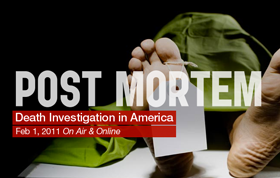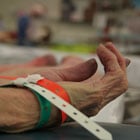Autopsies in the U.S.A.
Death investigations in the U.S. are often carried out in settings that bear little resemblance to the glitzy, high-tech morgues shown on television. When a death occurs under suspicious circumstances, the investigation into its cause is overseen by a coroner, often an elected official with no medical background, or a medical examiner, usually a doctor who specializes in forensic pathology. ProPublica, in partnership with PBS "Frontline" and NPR, surveyed almost 70 of the largest coroner and medical examiner systems in the U.S. More about the data »
A National Patchwork
Coroner and medical examiner systems vary widely from state to state and even county to county. Hover over each state to see what forensics systems are in place there.
Developers
Build something with this data using the ProPublica Forensics API.
ProPublica's Jeff Larson contributed to development. ProPublica interns Liz Day and Sydney Lupkin contributed research for this project as did Sheelagh McNeill, Kitty Bennett, Frontline's Jackie Bennion and NPR's Barbara Van Woerkom.
Corrections
The autopsy numbers originally reported for Utah were overstated because of a data collection error. The figures were for the total number of cases accepted, rather than just the number of autopsies performed. We have corrected those numbers and adjusted our regression formula based on the change. As a result, the percentage by which states rate of autopsies varied from expected levels shifted slightly in many cases. Three years of data for Utah 2004, 2005, 2006 -- moved from more than expected to as expected. In addition, two values Oklahoma for in 2007 and Massachusetts in 2004 -- moved from as expected to fewer than expected. Two values -- Alaska in 2006 and the District of Columbia 2004 -- moved from as expected to more than expected. This adjustment affects calculations for state autopsy systems only.
Alabama was originally labeled as having a state medical examiner and some county medical examiners. In fact, its system also includes some county coroners.
How Does Your System's Autopsy Rate Compare?
Fewer than expected
| System | Autopsy Rate vs. Expected |
|---|---|
| Arkansas Medical Examiner Ark. (statewide) |
-60%
in 2007 |
| Macomb County (Mich.) Medical Examiner Macomb County, Mich. |
-51%
in 2007 |
| Bergen County (N.J.) Medical Examiner Bergen County, N.J. |
-47%
in 2007 |
| Oregon Medical Examiner Ore. (statewide) |
-41%
in 2007 |
| Maine Medical Examiner Maine (statewide) |
-40%
in 2007 |
More than expected
| System | Autopsy Rate vs. Expected |
|---|---|
| Harris County (Texas) Institute of Forensic Sciences Harris County, Texas |
+87%
in 2007 |
| Vermont Medical Examiner Vt. (statewide) |
+85%
in 2007 |
| Fulton County (Ga.) Medical Examiner Fulton County, Ga. |
+68%
in 2007 |
| Pima County (Ariz.) County Medical Examiner Pima County, Ariz. |
+62%
in 2007 |
| Orange County Coroner System Orange County, Calif. |
+46%
in 2007 |
| All Systems » |
Watch FRONTLINE's documentary produced in conjunction with our story.
Related Stories from

Second Chances Underscore Flaws in Death Investigations
Despite a lengthening trail of errors that have spanned more than a decade, Dr. Thomas Gill has continued to do thousands of autopsies and to serve as an expert witness in criminal cases.
Flawed Autopsies Send Two Innocent Men to Jail
Levon Brooks and Kennedy Brewer are Mississippi men who spent a combined 30 years in prison for crimes they didn't commit. They were separately charged with sexually assaulting and murdering two 3-year-old girls — in two separate crimes — two years apart.
Safeguard the public interest.
Support ProPublica’s award-winning investigative journalism.
Become a Source
Do you work in the criminal justice system and have further insights into this story? Share your expertise »
Have you, or someone you know, been impacted personally by these issues? Share your story »
In collaboration with ![]()


